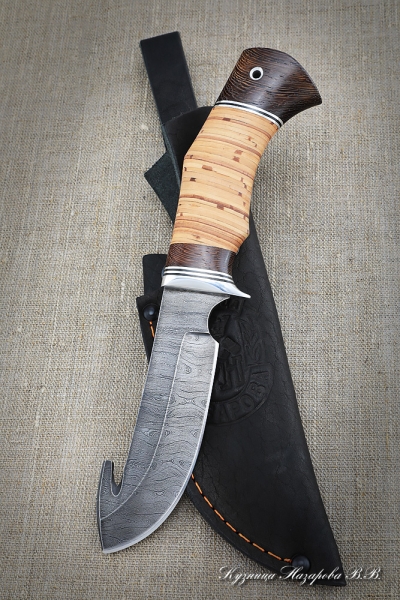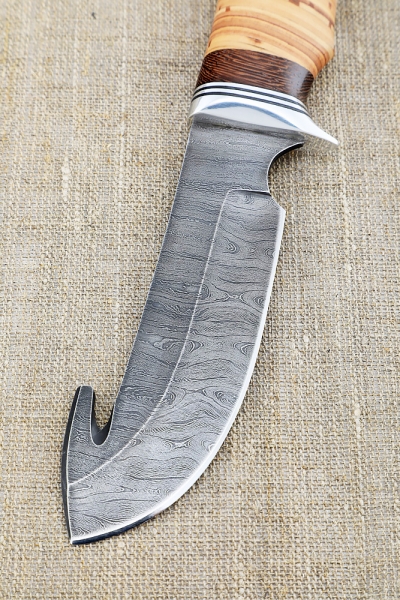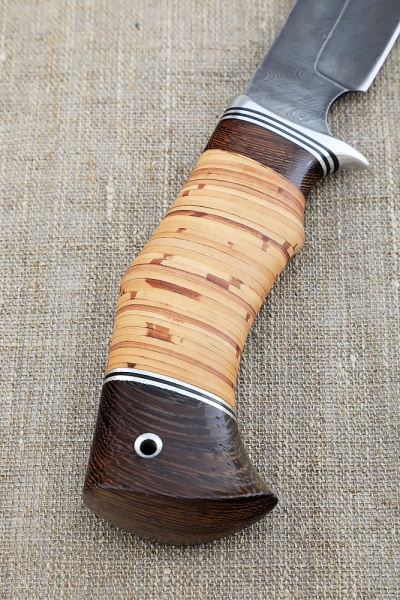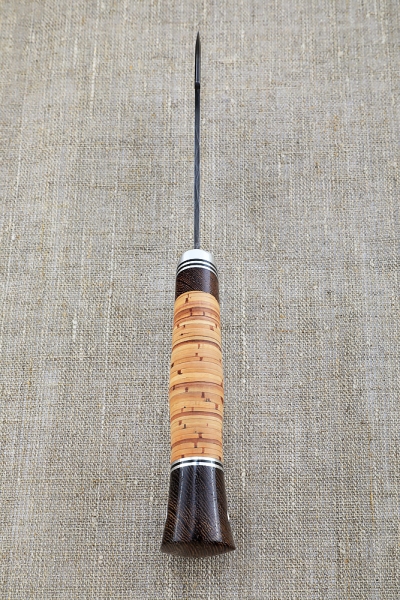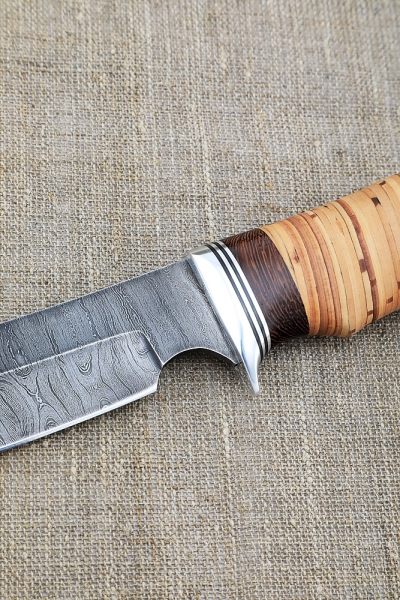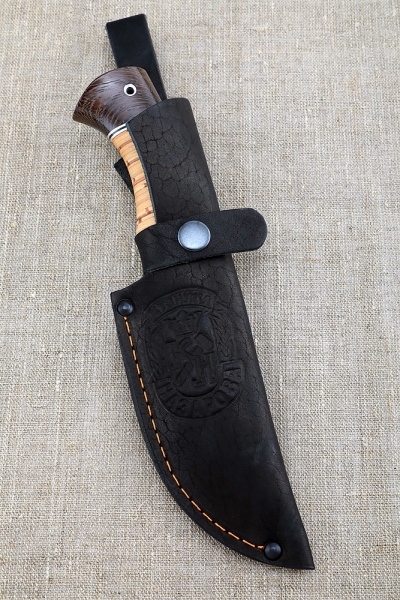- Главная
- Online knife shop
- By type of steel
- Damaskus knives
- Skinning knife Damascus birch bark
Skinning knife Damascus birch bark
Skinning knife Damascus birch bark
- Blade steel tipeDamascus
- Материал рукоятиБереста
- Lengtn blade (os)117 mm
- Witdth blade (os)35 mm
- Толщина клинка2.4 mm
- Lengtn handle (os) 117 mm
- Hardness (HRC)62
- Product weight, gram150
- SheathLeather
- КонструкцияФиксированные
- ОсобенностиС гардой
- Форма клинкаGut Hook
Detailed analysis of construction and materials
Blade steel – Damascus, hardness 62 HRC: The blade is made of high-quality Damascus steel, known for its stunning aesthetic properties (unique wavy pattern) and outstanding hardness characteristics. The hardness of 62 HRC provides excellent wear resistance: the knife retains its sharpness for a long time even during intensive use, does not require frequent sharpening, and is resistant to discoloration of the cutting edge. However, it should be borne in mind that high hardness can reduce impact strength – the knife is not designed for heavy chopping and contact with hard surfaces.
Handle material – Birch bark: Natural birch bark is a traditional material for premium knife handles. It is pleasant to the touch, fits perfectly in the hand, and provides a secure grip even in wet conditions (for example, when cutting carcasses or working outdoors). Birch bark is slip-resistant, feels warm in the palm of your hand, and does not cause discomfort at subzero temperatures. For additional protection from moisture and dirt, the handle is treated with a special compound.
Blade Shape – Gut Hook: The specialized shape with a “hook” on the butt is designed for ease of performing skin removal operations: The Gut Hook allows you to gently pry and cut the skin without damaging the internal organs of the animal. A blade of medium width (35 mm), length 117 mm and thickness 2.4 mm are optimal parameters for filigree work with meat, skinning, as well as performing fine cuts.
Handle and balancing: The handle length (117 mm) is carefully selected for a secure grip with any palm, and the presence of a guard ensures safety during operation — the hand will not slip onto the cutting edge. The knife demonstrates excellent control in different grip positions, does not tire the brush during prolonged work.
Scope of application: strengths and limitations
- Ideal for hunters and anglers.: Optimally adapted for butchering and skinning prey thanks to the gut hook. High hardness and sharpness guarantee efficiency in precision operations.
- Great for hiking, camping, meat work, fishing – where controlled cutting and tissue separation are important.
- The birch bark handle ensures a secure grip in wet or dirty conditions — it does not slip, even if the hand is covered in blood or liquid.
- Restrictions: It is not intended for heavy chopping operations (batoning, chopping branches and bones), working with hard objects (bones, large wooden blanks), as well as for opening canned food and other household tasks that require additional leverage.
Wear resistance, maintenance, resistance to moisture and corrosion
Damascus steel has good resistance to wear and corrosion, but requires careful care: it is recommended to thoroughly clean and wipe the knife after each use, especially after contact with moisture, meat or blood. Do not store in a damp sheath for a long time. Regular lubrication of the blade with a thin layer of oil will prevent the appearance of stains.
Birch bark is resistant to moisture, but to maintain aesthetic and operational condition, it is recommended to periodically treat the handle with a special compound for wooden surfaces.
Sharpening: Due to the high hardness of the blade, sharpening is performed less frequently, but it is better to use high-quality sharpening stones/ systems and observe the correct angle to avoid micro-staining of the cutting edge.
Unique and historical features
The use of Damascus steel is a tribute to the centuries—old traditions of knife making: each blade is unique, has a signature pattern and symbolizes the mastery of blacksmithing. The birch bark handle highlights the northern heritage — birch bark linings have long been used to create knives with a natural “warm” grip, which is especially appreciated when working in the cold.
Brief recommendations and conclusion
This knife will be an excellent choice for hunters, fishermen, collectors and connoisseurs of original products who value precise work when removing skins, comfortable grip in difficult weather conditions and handmade aesthetics. It is not suitable for those who are looking for a universal knife for household tasks or heavy work on wood and bones.
Care instructions: Always clean and dry the blade and handle after use, use oil to protect the blade, do not store it in a damp sheath for a long time. Birch bark requires minimal maintenance, but it can be treated with a special wood oil to maintain its appearance.
Conclusion: if you value handmade work, traditional materials and need a reliable tool for hunting, butchering and precise work with meat and fish, this knife is created especially for you.







